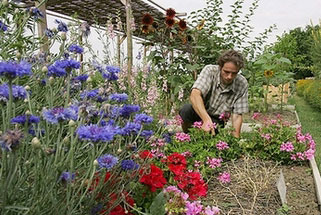Human Flower Project
Monday, July 17, 2006
The Palette of Plant Dyes
A French conservatory garden explores the modern-day potential of madder, roses and the lipstick tree.

Florent Valentin cares for the dye-producing plants at Lauris conservatory garden
Photo: Anne-Christine Poujoulat, for AFP
Isabelle Wesselingh, writing for Agence France Presse, introduces us to a garden experiment station in Southern France. In the town of Lauris, Provence, botanists are raising over 300 plants known for their dye properties and hoping to introduce these old color chemistries to a new generation of environmentally conscious textile companies.
Natural dyes like indigo and cochineal prevailed from 2,600 B.C. to the 19th century. “But many of the secrets of colour-producing plants have been lost with the growing dominance of the oil-based synthetic colours, which are cheap and fast to produce.” The Couleur Garance association is striving to revive the old dyes, a timely effort in that the European Union will be limiting oil-based products. Garance officials say they think that 10 years from now, 3% of the world’s textiles will be colored with natural dyes.
Many of these plants pack surprises: pomegranate, which one would except to stain bright orange, actually delivers yellow or black. Thyme, with purple flowers, produces yellow dye.
We’ve been traveling in the Heart of Dixie, Alabama, these past few days, and have learned that the grey uniforms of the Confederacy were dyed with butternut, a tree of the walnut family.
Perhaps some of our readers have visited the Garance garden or will be able to attend the November conference in Hyderabad, India, symposium on the future of natural dyes.
For more on plant dyestuffs, check here. We’re particularly interested in floral dyes. If you’re out there experimenting, please send us your results: word, image, color swatch, or all three.




